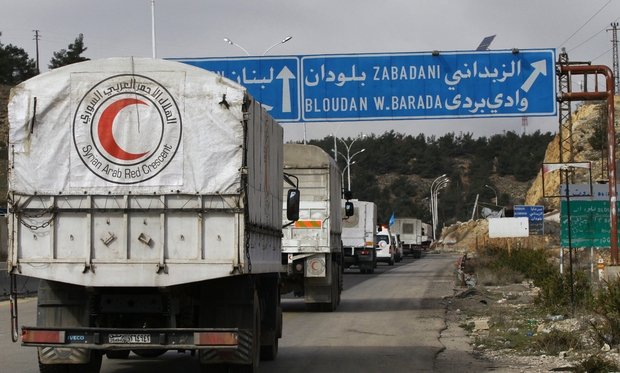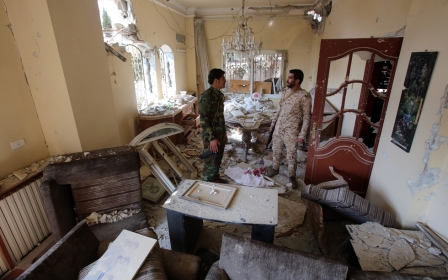How to end Syria's sieges

Heart-rending images come out of the Syrian war with such regularity that one would almost be forgiven for becoming inured to their horror. This is how global callousness sets in, and there are reasons for it.
But a series of photographs which were propagated last month challenged this collective emotional hardness. They documented the young life of Sahar Dofdaa, a terribly emaciated infant born in East Ghouta, which has been under siege by forces loyal to the Syrian President Bashar al-Assad since 2012.
The siege as a tool
Sieges are a particularly prominent feature of Syria's civil war. They have been a notable instrument of policy for the Syrian government - while armed opposition groups, Syrian Kurds and Islamist factions, including the Islamic State (IS), have also mounted sieges.
The latest report produced by Siege Watch, an organisation which monitors Syria's sieges, estimates that over a million Syrians are living under siege with a further 1.3 million on its siege "watchlist", which means that inhabitants are either living under conditions close to a siege or are at risk of doing so.
Siege Watch numbers more than 50 areas under siege or at risk of it. Those under siege or on the organisations "watchlist" include two communities in Idlib (besieged by Jaish al-Fatah insurgents); three in Homs (all besieged by Syrian government forces); four to eight in Damascus and the rural areas surrounding it (mostly besieged by government forces and its allies); Deir Ezzor (previously besieged by IS); and Aleppo (was besieged by government forces until late 2016 and still at risk).
This does not include depopulated areas such as the city of Raqqa, which was previously under intense siege by the Kurdish-led Syrian Democratic Forces (SDF) as part of the anti-IS campaign.
The Syrian government and various rebel factions have negotiated "reconciliation" agreements to allow combatants to leave besieged areas and to end sieges. This process has taken a more formal structure since 2016.
Though on the face of it these agreements are intended to end sieges and civilian suffering, observers such as Amnesty International have argued that these agreements often result in expulsions and forcible population transfers, and have served as part of the government's broader war strategy.
Forced transfer
The present crisis in East Ghouta began nearly five years ago. Four hundred thousand people inhabit the area, which is currently under siege by government forces. This siege has grabbed international attention as the situation has deteriorated, with civilians starving and many at risk of malnutrition or death.
By suggesting that besiegers can be negotiated with, these measures legitimise and even reward the use of siege tactics
What is happening in East Ghouta resembles the starvation siege of Madaya, a small mountain town which was cut off by pro-government forces for nearly two years. After the first year, aid organisations suggested that at least 65 people had starved to death there. The people of Madaya went months without external supplies of food.
The suffering of Madaya and nearby rebel-held Zabadani came to an end not with relief, but with evacuation, as rebels and the regime struck a deal to vacate the towns.
Population transfers of this sort, estimated in Madaya and Zabadani to include 2,100 people, with rebel fighters among them, barely solve the problem. Nor do sporadic, negotiated deliveries of aid.
Though each can be justified in terms of practical expediency – better to do something than nothing – both have a negative effect. By suggesting that besiegers can be negotiated with, these measures legitimise and even reward the use of siege tactics.
As an example, the deal which ended the Madaya and Zabadani sieges included a corollary: the slackening of Islamist insurgent sieges of government-held Fouaa and Kefraya, towns in Idlib province. These sieges are still ongoing. All this strikes a bitter note.
Systematic brutality
No wonder that, during a recent visit of a United Nations aid convoy, inhabitants of East Ghouta held banners and signs in protest. They protested against receiving aid as an alternative to breaking the siege for good.
Sieges represent a clear distillation in public view of both the extent to which the conflict in Syria has degenerated into systematic brutality, and the government's deliberately savage war strategy.
Though many of the combatants in Syria use sieges, the government mounts the most, accounting for all the sieges in Homs governorate and the majority of the sieges in Damascus governorate.
Syria's sieges represent a challenge to the world. How it deals with besieged communities and those laying sieges matters, as any pressing humanitarian crisis does. But Syria's sieges also merit special importance now the war is so advanced.
A first step
The territory held by IS is waning. It provided a focus for the international community, sometimes at the expense of the civilian toll of the rest of the Syrian civil conflict.
Now that the campaign against IS's self-declared state ends and shifts to combating an insurgency, the world cannot forget about the rest of the civilian suffering in Syria. How other countries respond to the sieges of Syria will help define how their role in the war is perceived.
It has long been proposed, notably in the United Kingdom by European parliamentarians including Jo Cox, an MP who was murdered last year, that British forces should mount humanitarian aid drops to feed besieged and starving Syrians.
Ending Syria's sieges will be difficult and cannot be solved with aid drops alone. It would need determination. But it matters that the nations of the world take a first step. That means renouncing passivity and embracing action.
Ending Syria's sieges will be difficult and cannot be solved with aid drops alone
It would require an internationalist vision and political bravery uncommon in the present moment. But such things are necessary. They matter in confronting the greatest humanitarian crisis of our age and its gravest moral challenge.
People are starving as Syria suffers under ongoing sieges. The "reconciliation" agreements have proven to be anything but. But these sieges could be lifted, if only the outside world resolved to act.
- James Snell is a British journalist who has written for numerous international publications, including National Review, The American Spectator, New Humanist and Free Inquiry.
The views expressed in this article belong to the author and do not necessarily reflect the editorial policy of Middle East Eye.
Photo: Children from the family of Umm Saeed wait to eat a meal of corn and cabbage on 6 November 2017 in Saqba, in the besieged rebel-held Eastern Ghouta area near Damascus. It has been under a tight government siege since 2013, causing shortages of food and medicine. ( Abdulmonam Eassa/AFP).
This article is available in French on Middle East Eye French edition.
New MEE newsletter: Jerusalem Dispatch
Sign up to get the latest insights and analysis on Israel-Palestine, alongside Turkey Unpacked and other MEE newsletters
Middle East Eye delivers independent and unrivalled coverage and analysis of the Middle East, North Africa and beyond. To learn more about republishing this content and the associated fees, please fill out this form. More about MEE can be found here.







